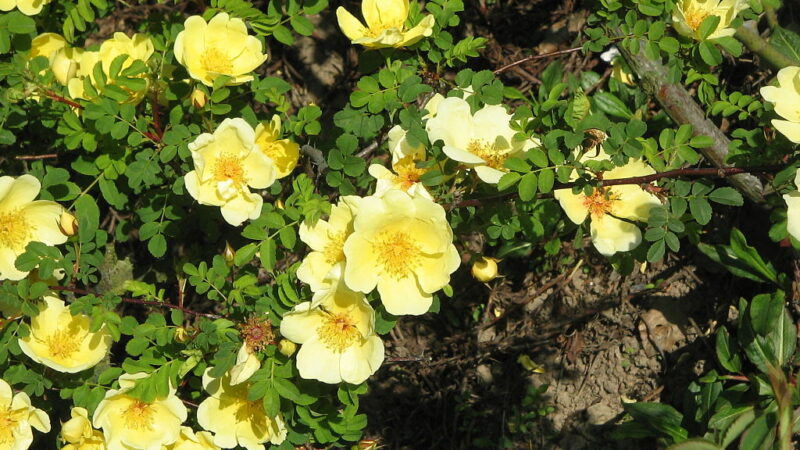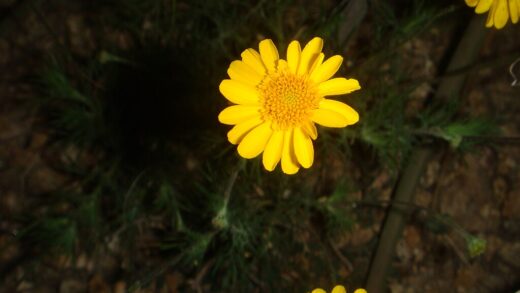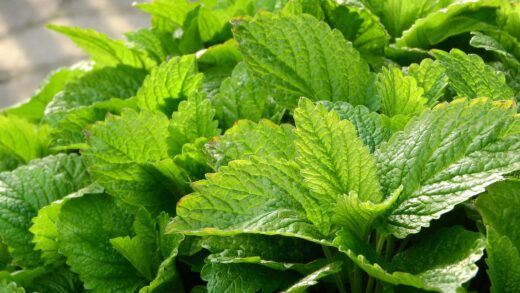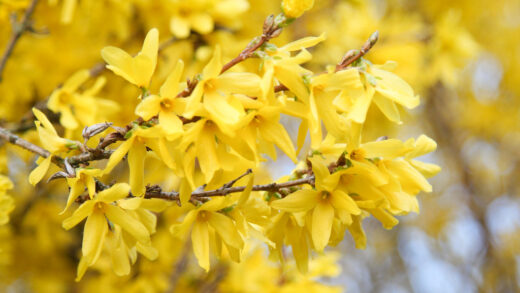The care of the golden rose

The golden rose, known scientifically as Rosa xanthina, is a truly spectacular shrub that can bring a burst of sunshine to any garden with its vibrant yellow blooms. Native to central China, this species is not just admired for its beauty but also for its remarkable resilience and relatively straightforward care requirements, making it a suitable choice for both novice and experienced gardeners. Proper care, encompassing everything from selecting the right location to understanding its seasonal needs, is fundamental to unlocking its full potential. Ensuring this rose thrives involves a holistic approach that considers its entire life cycle, promising a breathtaking display of golden flowers year after year. A healthy golden rose is not only a visual delight but also a robust plant capable of withstanding common garden challenges with grace.
Understanding the fundamentals
Successful cultivation of the golden rose begins with a solid understanding of its basic environmental preferences. This species flourishes in conditions that mimic its native habitat, which consists of open slopes and scrubby areas. Therefore, providing ample sunlight is paramount for vigorous growth and prolific flowering. An ideal location offers at least six hours of direct sunlight daily. While it can tolerate some light shade, the quantity and quality of blooms may be noticeably reduced in less sunny spots. Furthermore, good air circulation is crucial in preventing common fungal diseases that can affect roses, so avoid planting it in overly crowded or stagnant areas of the garden.
Beyond sunlight, the soil composition plays a vital role in the long-term health of the golden rose. It performs best in organically rich, medium-moisture, well-drained loams. Although it exhibits a degree of tolerance for poorer soils, amending the planting area with compost or well-rotted manure will provide a significant advantage. Proper drainage is non-negotiable, as waterlogged conditions can lead to root rot, a serious and often fatal issue for many rose species. Before planting, it is wise to assess the soil structure and, if necessary, improve heavy clay soils with organic matter to enhance their drainage and aeration capabilities.
The plant’s growth habit also informs its care. Rosa xanthina grows into a large, arching shrub, typically reaching heights and spreads of six to nine feet. This substantial size must be considered when choosing a planting location, ensuring it has adequate space to mature without encroaching on other plants or garden structures. Its arching canes, armed with reddish-brown thorns, create a natural, informal appearance. This growth characteristic means that it is generally low-maintenance in terms of shaping, though some pruning is beneficial for health and structure, which we will explore in more detail later.
Finally, understanding its flowering cycle is key to appreciating this beautiful shrub. The golden rose produces a stunning, dense bloom of semi-double yellow flowers for several weeks in late spring, typically from late April into May. Unlike many modern hybrid roses, this species does not typically repeat bloom, although a sparse re-flowering in early autumn is sometimes possible. This single, magnificent flush of flowers is a hallmark of the species, followed by the development of attractive red hips in late summer that provide winter interest and food for wildlife.
More articles on this topic
Seasonal care throughout the year
Spring is a season of vigorous activity for the golden rose, and proper care during this time sets the stage for a successful year. As new growth emerges, it is the ideal time to apply a balanced, slow-release fertilizer formulated for roses. This provides the necessary nutrients to support the development of healthy foliage and an abundance of flowers. Additionally, applying a layer of organic mulch, such as compost or shredded bark, around the base of the plant is highly beneficial. Mulching helps to retain soil moisture, suppress weed growth, and keep the root zone cool as temperatures begin to rise.
As the plant bursts into its spectacular bloom in late spring, the primary care task is simply to enjoy the show while keeping an eye out for any emerging issues. Monitor the plant for early signs of pests or diseases, as prompt action can prevent significant problems. Ensure the soil remains consistently moist but not waterlogged, especially during dry spells leading up to and during the flowering period. After the glorious flowering display has finished, a light pruning to remove spent blooms can tidy the plant’s appearance, though this will sacrifice the development of the attractive rose hips later in the season.
Summer care for the golden rose focuses on maintaining health and hydration. Regular watering is crucial, particularly during hot, dry periods. It is best to water deeply and less frequently, encouraging the root system to grow deeper into the soil where it is more resilient to drought. Morning watering is preferable, as it allows the foliage to dry quickly, reducing the risk of fungal diseases. Avoid overhead watering for the same reason; instead, apply water directly to the soil at the base of the plant. Continue to monitor for pests and diseases throughout the summer months.
Autumn is a time for the plant to wind down and prepare for dormancy. The golden rose will begin to produce its characteristic red hips, which add a wonderful splash of color to the autumn garden and persist into winter. Reduce watering frequency as the weather cools and rainfall increases. It is also a good time to perform a general cleanup around the base of the plant, removing any fallen leaves or debris that could harbor disease spores or pest eggs over the winter. This simple act of garden hygiene can significantly reduce the likelihood of problems in the following spring.
Soil management and nutrition
The foundation of a healthy golden rose is healthy soil. This shrub thrives in soil that is rich in organic matter, which provides essential nutrients and improves soil structure. Before planting, incorporating several inches of compost, aged manure, or leaf mold into the top foot of soil will create an ideal growing environment. This initial soil preparation gives the rose a strong start and supports robust root development. For established plants, an annual top-dressing of compost in the spring will help to replenish nutrients and maintain the soil’s organic content over time.
A balanced nutritional program is key to promoting lush foliage and a profusion of flowers. While the golden rose is not an exceptionally heavy feeder, it benefits from regular fertilization during the growing season. A granular, slow-release rose fertilizer applied in early spring as new growth begins is an excellent choice. Look for a product with a balanced N-P-K (Nitrogen-Phosphorus-Potassium) ratio. Nitrogen supports leafy growth, phosphorus encourages strong root and flower development, and potassium contributes to overall plant vigor and disease resistance. A second, lighter application can be made after the main flowering flush to support the plant’s health through the summer.
Understanding the soil’s pH is another important aspect of nutrient management. Roses generally prefer a slightly acidic to neutral soil pH, ideally between 6.0 and 7.0. Most garden soils fall within this range, but it can be beneficial to perform a simple soil test to be certain. If the soil is too alkaline or too acidic, it can lock up certain nutrients, making them unavailable to the plant even if they are present in the soil. Soil pH can be adjusted over time using amendments like lime to raise the pH (make it more alkaline) or sulfur to lower the pH (make it more acidic), following the recommendations of the soil test.
It is crucial to avoid over-fertilizing, as this can do more harm than good. Excessive nitrogen, for example, can promote a lot of lush, weak foliage at the expense of flowers and can make the plant more susceptible to pests like aphids. It can also lead to fertilizer burn, which damages the roots. Always follow the application rates recommended on the fertilizer packaging. Cease all fertilizing by late summer to allow the plant to harden off properly before winter, as new, tender growth stimulated by late-season feeding is vulnerable to frost damage.
Water wisdom
Proper watering techniques are fundamental to the health and vitality of the golden rose. The goal is to provide consistent moisture to the root zone without creating waterlogged conditions. Deep, infrequent watering is far more effective than shallow, frequent sprinkling. A thorough soaking encourages the roots to grow deeper into the soil profile, which makes the plant more resilient and drought-tolerant over time. A good rule of thumb is to provide the equivalent of about one inch of rainfall per week during the active growing season, adjusting based on weather conditions and soil type.
The best time of day to water is in the early morning. This allows the water to soak into the soil and be absorbed by the roots before the heat of the day causes significant evaporation. Morning watering also ensures that any moisture on the leaves has ample time to dry in the sunlight, which is a key strategy for preventing the development and spread of fungal diseases like black spot and powdery mildew. Watering in the evening, by contrast, can leave the foliage damp overnight, creating an ideal environment for these pathogens to thrive.
The method of watering is just as important as the timing and frequency. It is always best to apply water directly to the base of the plant, soaking the soil around the root zone. Using a soaker hose or a drip irrigation system is an excellent way to deliver water efficiently and directly where it is needed most, minimizing waste and keeping the foliage dry. If watering by hand with a hose or watering can, take care to avoid splashing water up from the soil onto the leaves, as this can also spread fungal spores.
Recognizing the signs of both under-watering and over-watering is a crucial skill for any gardener. An under-watered rose may exhibit wilting leaves, yellowing foliage, and a general lack of vigor. Conversely, an over-watered plant can also show yellowing leaves, but they may feel soft and limp, and the plant might suffer from root rot, which can cause stunted growth and eventual plant death. Checking the soil moisture with your finger before watering is a simple and reliable method; if the top two to three inches of soil feel dry, it is time to water.
Pruning for health and shape
Pruning is an essential maintenance task that promotes the health, vigor, and overall appearance of the golden rose. The primary time for pruning this species is in late winter or early spring, just before new growth begins. The main objectives are to remove any dead, damaged, or diseased wood, which helps to prevent the spread of pathogens and encourages the plant to direct its energy towards healthy new growth. Using clean, sharp pruning tools is crucial to make precise cuts that heal quickly and minimize stress on the plant.
When making pruning cuts, it is important to understand the plant’s structure. First, identify and remove any canes that are clearly dead, which will be dry, brittle, and often discolored. Next, look for any canes that are damaged, broken, or showing signs of disease, such as cankers. These should be cut back to healthy, white wood. It is also beneficial to remove any canes that are crossing or rubbing against each other, as this can create wounds that provide entry points for diseases. This thinning process improves air circulation through the center of the shrub, which is vital for disease prevention.
Beyond the removal of the three ‘D’s (dead, damaged, and diseased wood), some structural pruning can be done to maintain a desirable shape and size. Rosa xanthina has a naturally graceful, arching habit that should be respected. Lightly shaping the plant by trimming back some of the longest canes can help to maintain a more compact form if desired. However, avoid shearing the plant into a formal hedge, as this will destroy its natural character. Since this rose blooms on old wood from the previous year’s growth, heavy pruning should be avoided, as it will significantly reduce the number of flowers for the upcoming season.
After the spring flowering has concluded, a very light pruning can be performed if necessary. This typically involves deadheading, which is the removal of spent flowers. On a large shrub like Rosa xanthina, this can be a time-consuming task and is entirely optional. Keep in mind that removing the faded blooms will prevent the formation of the attractive red rose hips that provide fall and winter interest. Therefore, many gardeners choose to forgo deadheading this particular species to enjoy the secondary display of fruit.
Pest and disease management
Even with the best care, the golden rose can occasionally fall prey to common garden pests and diseases. A proactive approach, focused on prevention and early detection, is the most effective strategy for management. Creating a healthy growing environment is the first line of defense. A well-sited plant in full sun with good air circulation, growing in fertile, well-drained soil, is naturally more resilient and less susceptible to problems. Regular monitoring of the plant allows for the early identification of issues before they become widespread.
Common pests that may affect roses include aphids, spider mites, and sawfly larvae. Aphids are small, sap-sucking insects that tend to congregate on new growth and flower buds. A strong jet of water from a hose can often be enough to dislodge them. For more persistent infestations, insecticidal soap or neem oil sprays are effective and relatively low-impact options. Spider mites, which are tiny and difficult to see, thrive in hot, dry conditions and can cause stippling on the leaves. Increasing humidity by hosing down the foliage can help deter them.
Fungal diseases are perhaps the most common issue for roses. Black spot, powdery mildew, and rust are all potential problems. Black spot appears as dark, circular spots on the leaves, which then turn yellow and drop. Powdery mildew presents as a white, dusty coating on leaves and buds. Rust causes orange-colored pustules on the undersides of leaves. The key to controlling these diseases is prevention through good cultural practices: watering at the base of the plant, ensuring good air circulation, and cleaning up fallen leaves and debris. If fungal diseases do appear, fungicidal sprays may be necessary.
When choosing to use any form of treatment, whether organic or synthetic, it is crucial to do so responsibly. Always identify the specific pest or disease accurately before applying any product. Read and follow the label instructions carefully, paying attention to application rates and safety precautions. Whenever possible, opt for the least toxic solution first. Encouraging natural predators, such as ladybugs and lacewings, into the garden can also provide a natural and effective form of pest control, creating a healthier and more balanced garden ecosystem.
Winter preparations
Preparing the golden rose for winter is an important final step in its annual care cycle, particularly in colder climates. Although Rosa xanthina is quite hardy, typically thriving in zones 5 through 9, providing some winter protection can help ensure its survival and a strong start the following spring. The goal of winter protection is not to keep the plant warm, but rather to insulate it from fluctuating temperatures and protect it from harsh, drying winds and sun scald. Preparations should begin in the autumn after the first few light frosts.
One of the most effective methods of winter protection is to apply a thick layer of mulch around the base of the plant. After the ground has started to freeze, mound about 10 to 12 inches of loose material, such as shredded leaves, straw, or compost, over the crown of the rose. This insulation helps to keep the ground temperature stable, preventing the damaging effects of repeated freezing and thawing cycles. It is important to wait until after a few frosts to apply the mulch, as applying it too early can delay the plant’s dormancy.
In addition to mulching, protecting the canes from winter winds is beneficial, especially for younger or more exposed plants. The wind can desiccate the canes, leading to dieback. Creating a windbreak or wrapping the shrub loosely with burlap can offer significant protection. This is particularly important in regions with little reliable snow cover, as a thick blanket of snow acts as a natural and excellent insulator for the lower parts of the plant.
Once spring arrives and the threat of hard frost has passed, it is time to undo the winter protection. Gently remove the mound of mulch from around the base of the plant, spreading it out as a top dressing in the garden bed. Remove any burlap wraps to allow for air circulation and the emergence of new growth. This is also the perfect time to perform the annual pruning, removing any canes that may have been damaged during the winter months and shaping the plant for the new growing season.
📷 Meneerke bloem, CC BY-SA 3.0, via Wikimedia Commons



















